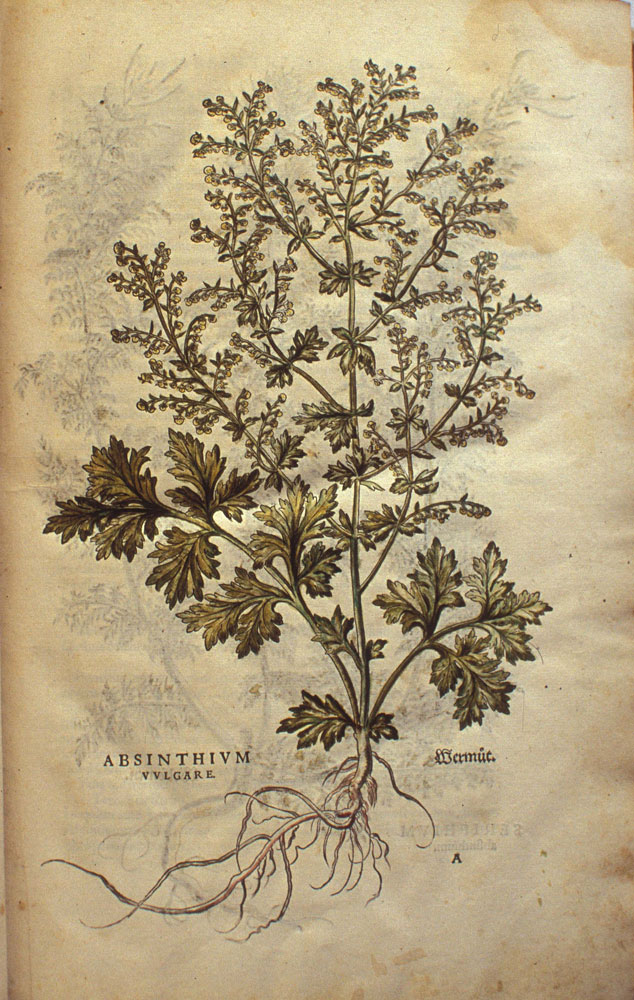Among the plants that have retained the names of the regions from which they were formerly transported.
Notes
Absinthium vulgare

Absinthium vulgare
Artemisia absinthium L.
Ancient Greek: apsinthion
English: wormwood
Sautonica
Ozell emends Urquhart’s translation: “Read Santonica, which Cotgrave interprets the Seed of Holy Wormwood. Cambridge Dict. says French Wormwood, and in that case it may have its name from Saintonge in France.”
Santonica
Pliny xxvii. 7, § 28. A kind of Vermouth: “Absinthii genera plura sunt; Santonuicum appellatur e Galliae civitate.”
santonica
Absinthii genera plura sunt: Santonicum appellatur e Galliae civitate, Ponticum e Ponto, ubi pecora pinguescunt illo et ob id sine felle reperiuntur, neque aliud praestantius,multoque Italicum1 amarius, sed medulla Pontici dulcis. de usu eius convenit, herbae facillimae atque inter paucas utilissimae, praeterea sacris populi Romani celebratae peculiariter, siquidem Latinarum feriis quadrigae certant in Capitolio victorque absinthium bibit, credo, sanitatem praemio dari honorifice arbitratis maioribus. stomachum corroborat, et ob hoc sapor eius in vina transfertur, ut diximus. bibitur et decoctum aqua ac postea nocte et die refrigeratum sub divo, †decoctis sex drachmis foliorum cum ramis suis in caelestis aquae sextarii tribus, oportet et salem addi. vetustissimum usu est†. bibitur et madefacti dilutum, ita enim appelletur hoc genus. diluti ratio ut, quisquis fuerit modus aquae, tegatur per triduum.
There are several kinds of wormwood. The Santonic comes from the state of the Santoni in Gaul, the Pontic from Pontus, where cattle fatten on it, and so are found to be without gall; there is no finer wormwood than this, the Italian being far more bitter, but the pith of Pontic wormwood is sweet. About its use there is general agreement, for it is a plant very easily found, and one of the most useful, being moreover especially honoured at the religious rites of the Roman people, seeing that at the Latin festival there is a race for four-horse chariots on the Capitoline Hill, the winner of which takes a draught of wormwood, our ancestors thinking, I believe, that health was a very grand prize to give. It strengthens the stomach and for this reason it is used, as I have said, to give a flavour to wines. A decoction in water, which is afterwards cooled in the open for a day and a night, is also taken; six drachmae of the leaves with their branches are boiled down in three sextarii of rain water; salt too should be added. When very old it can still be used. There is also administered an infusion of wormwood in water; for this preparation should be styled “infusion,” and an essential of the infusion is that, whatever quantity of water is used, for three days the preparation should be wholly enclosed.
santonicque
« Santonicum appellatur e Galliæ civitate ». Pline, XXVII, 28. Plante qui pousse au pays des Santones (Saintes). « Absinthe xaintonicque », dit Bernard Palissy (Des Pierres). Le Santonicum (genus absinthii) de Pline serait, pour Fée, Artemisia santonica L., mais cette dernière est une espèce tartare et persane qu’on ne sauraut trouver en Saintonge. L’absinthe xaintonique de Palissy est, d’apres Audiat, Artemisia maritima, L., hôte habituel de notre côte atlantique, et dont une var. porte le nom d’A. sauveolens, Lmk., = A. santonica, Woodv. (Paul Delaunay)
santonica
santonica, or absinthe, from Sanitonge, the region about Saintes…
Santonicque
Plante du pays des Santones (Saintes) (Pline, XXVII, xxviii).
Saintonge
Saintonge is a small region and historical province on the Atlantic coast of France within the département Charente-Maritime, west and south of Charente in the administrative region of Poitou-Charentes. It derives its name from the ancient Gallic tribe of the Santones who lived in this area, around the current city of Saintes.
The Saintonge was the center of the French Huguenots.
santonica
santonica [adopted from Latin Santonica (sc. herba), a kind of wormwood, singular of Santonicus pertaining to the Santones or Santoni, a people of Aquitania. The plant was also called absinthium Santonicum (Pliny), Greek (ayinqion) santonikon, santonion. Cf. 16th century French santonique.]
The dried unexpanded flower-heads of species of Artemisia, produced in Turkestan, used as an anthelmintic; Levant or Alexandrian wormseed.
1658 J. Rowland Moufet’s Theat. Ins. 1119 Such things as we said to be good against Worms… such as are Wormwood, Southernwood, Santonicum.